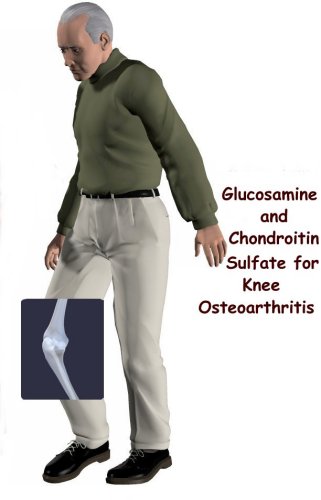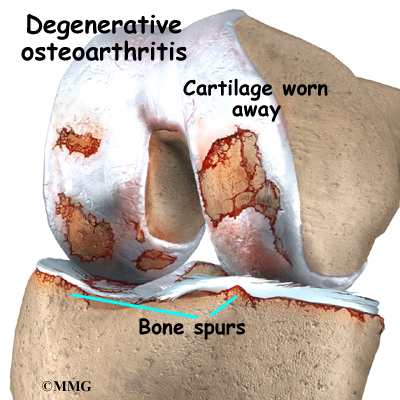Glucosamine and Chondroitin Sulfate for Osteoarthritis of the Knee
A Patient’s Guide to Glucosamine and Chondroitin Sulfate for Osteoarthritis of the Knee
Introduction

Nonsurgical treatment of knee osteoarthritis (OA) focuses on reducing pain and maintaining or improving joint function. Doctors commonly prescribe acetaminophen and nonsteroidal anti-inflammatory drugs (NSAIDs) to relieve pain and swelling in arthritic patients. Newer NSAIDs called COX-2 inhibitors are showing promise as well.
In recent years, two unique compounds have been used by people with knee OA. These compounds are gaining greater acceptance among many doctors. Glucosamine and chondroitin sulfate are dietary supplements usually taken in pill form that are thought to protect and possibly help repair cartilage cells.
Glucosamine and chondroitin sulfate are somewhat controversial treatments. While some studies have supported their effectiveness in relieving the symptoms of knee OA, the research still leaves many unanswered questions, especially about long-term effects.
This guide will help you understand
- what doctors believe the supplements can do
- how the treatments are administered
- what to expect after treatment
Anatomy
What part of the knee joint does OA affect?
The main problem in knee OA is degeneration of the articular cartilage. Articular cartilage is the smooth lining that covers the ends of bones where they meet to form the joint. The cartilage gives the knee joint freedom of movement by decreasing friction.

The articular cartilage is kept slippery by joint fluid made by the joint lining (the synovial membrane). The fluid, called synovial fluid, is contained in a soft tissue enclosure around synovial joints called the joint capsule.
An important substance present in articular cartilage and synovial fluid is called hyaluronic acid. Hyaluronic acid helps joints collect and hold water, improving lubrication and reducing friction. It also acts by allowing cells to move and work within the joint.

When the articular cartilage degenerates, or wears away, the bone underneath is uncovered and rubs against bone. Small outgrowths called bone spurs, or osteophytes, may form in the joint.
Rationale
What do doctors hope to achieve with these compounds?
Glucosamine and chondroitin sulfate occur naturally in the body, mainly in joint cartilage. They can also be made and given in pill form or by injection. The theory is that these supplements can help protect, or possibly even repair, damaged cartilage. Scientific studies lend support to the benefits that these supplements have on reducing pain, swelling, and tenderness, along with improving knee joint mobility.
Laboratory experiments suggest that glucosamine introduced to the body is absorbed by the synovial fluid. Glucosamine supplements also seem to encourage production of hyaluronic acid. Doctors think that normal hyaluronic acid levels in the knee joint keep the cartilage healthy and suppress pain in patients with knee OA.
Glucosamine and chondroitin sulfate also help fight inflammation, which in turn reduces joint pain, swelling, and tenderness from knee OA. These compounds seems to work in a different way than NSAIDs. They take longer to achieve the same beneft, but the results tend to last longer than NSAIDs. Most importantly, they have fewer side effects than NSAIDs. It’s possible that some patients may get good pain relief with a combination of the two.
Though the data isn’t conclusive, these two supplements have been shown to decrease pain and improve joint mobility in patients with knee OA. Most people start to notice a difference after taking the supplements for four weeks. Maximum benefits happen by eight to 12 weeks, and the benefits seem to last even after treatment has ended.
Preparation
How will I prepare for treatment?
Begin by gathering information. The Arthritis Foundation provides valuable information about these two supplements (www.arthritis.org).
Talk to your doctor. Not all forms of arthritis respond to these supplements. Realize that taking care of knee OA involves many possible treatments. Glucosamine and chondroitin sulfate are not magic bullets. They are one form of treatment in a comprehensive approach to knee OA.
Procedure
How are these treatments administered?
Doctors commonly prescribe oral glucosamine in doses of 500 milligrams three times per day or 1,000 milligrams twice per day. A patient may get a quicker response with a higher dosage. Obese patients may require higher dosages. Most studies of chondroitin sulfate use a dosage of 1,200 milligrams daily.
Complications
What might go wrong?
One potential benefit beyond pain relief for both glucosamine and chondroitin sulfate seems to be that patients experience fewer side effects with these drugs than with NSAIDs.
Most people can take these supplements without complications. The main complaints are gastrointestinal problems. These clear up when patients stop taking the supplement. Although rare, negative reactions may include nausea and vomiting, headache, painful digestion, softened or loose stool, abdominal pain, heartburn, throbbing or fluttering of the heart, skin reaction, edema (swelling), and discomfort in the legs.
Patients who take numerous medications should seek the advice of their doctor before supplementing with glucosamine and chondroitin sulfate. As glucosamine sulfate affects the way insulin works, diabetics are encouraged to monitor their blood glucose levels carefully and to alert their doctor of any marked changes. Also, children, pregnant women, and patients who are on blood thinners should only take chondroitin sulfate with the approval of their doctor.
After Care
What happens after treatment?
Many patients report ongoing benefits, even after they stop taking these supplements. Past studies have shown that the ability of these compounds to fight inflammation may be slower to take effect than NSAIDs. Yet the benefits seem to outlast NSAIDs. Until further studies are done, it is not proven that these supplements rebuild damaged cartilage. Given the possible protection to the cartilage, however, some doctors have their patients use these supplements in hopes of maintaining joint health.
Rehabilitation
Alhough glucosamine and chondroitin sulfate appear to have a useful place in treating knee OA, it is not recommended they be used alone. Managing knee OA works best using a variety of proven strategies. Patients do best when they also
- Get aerobic exercise.
- Do strengthening and range-of-motion exercises. These are most often taught and monitored by a physical therapist.
- Lose weight.
- Use heat and cold packs.
- Wear wedged insoles in their shoes.
- Use equipment to help take pressure off the joints, such as a cane.
- Participate in education programs or support groups.
By decreasing pain and increasing joint movement, glucosamine and chondroitin sulfate may help patients maximize their ability to take care of their knee OA. Be sure to talk to your doctor to see whether these supplements will benefit your particular condition.